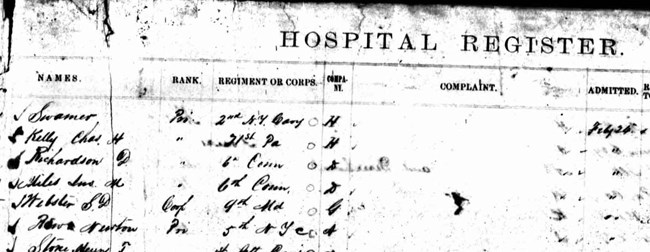
National Archives, Microfilm Publication m1303 For a prison whose existence spanned fourteen months it can be difficult to lock down the key dates of operation, and as a result there are a lot of misconceptions or confusion about the dates associated with Andersonville. For example, many of the "This Day in History" websites, Facebook pages, Twitter feeds, books, and historians incorrectly identify the date of the first prisoners' arrival as February 25, 1864 or even the 27th. However, the actual date of the first prisoners' arrival was February 24, 1864. While we do not know all of the details of that day, the hospital register clearly identifies prisoners being admitted to the Camp Sumter hospital on February 24. Perhaps these men were not yet inside the incomplete stockade, but this document confirms that Union prisoners were in Confederate hands at Andersonville on this date. Providing further confirmation that prisoners were present on the 24th is a letter to the editor that appeared in the Macon Telegraph on the 27th. The letter, dated February 25th, describes visiting the prison and speaking with prisoners "yesterday." With an event like Andersonville that is measured in months as opposed to days, it is easy to mix up dates. Even prisoners sometimes mixed up the dates. For example, prisoner Oliver Fairbanks claimed that he arrived on February 22. The two most common dates attributed as the first day of operation are February 25 and February 27th. The 25th date originates with a story that the prisoners arrived on the evening of the 24th but were not physically marched through the gates until the morning of the 25th. Whether or not this is true is subject to some speculation, but from the prison records it is clear that prisoners were present at the prison site on the 24th. February 27th is sometimes noted as the first day of the prison's operation. This is a simple mix up – February 27th is the date of the first prisoner death. On this date Adam Swarner (initially recorded as his brother Jacob Swarner) died of pneumonia, becoming the first of 12,920 men to die at Andersonville. The dates of other events at Andersonville are subject to some confusion and misconception. For example, prisoners report such a range of dates for the appearance of Providence Spring that it's nearly impossible to identify which date is correct. Prisoner diaries and memoirs claim dates ranging from August 5 to August 16 as the date of the spring's appearance. Even the date of the last death is subject to inconsistency. The last prisoner death to be recorded in the burial registry was Knud Hanson, who died April 28, 1865. However, the Confederate headcount roster notes that two prisoners died on May 5, but no burial record exists for these two men. The inconsistency of dates at Andersonville can be frustrating, especially for people who are interested in the Civil War. As we've gone through the 150th Anniversary of the Civil War over these last few years, much has been made about specific dates and anniversaries. Years of preparation went into planning April 12, 2011 in Charleston and thousands descended on southern Pennsylvania July 1-3, 2013. On September 17, 2012 and again on January 1, 2013, people around the country commemorated the Emancipation Proclamation. Historic sites and reenactor groups have spent years planning for a single day or a single weekend. But, in a sense, these dates are somewhat arbitrary as they mark not an end, but a beginning. For the men who fought in these battles, their memories and sufferings did not fade with the cessation of fighting. February 24 may be the anniversary of the first prisoners arriving, but for the 400 or so men who entered these gates, this date was not an ending, nor a culmination of planning. It was the beginning of a journey that took these men into the darkest recesses of human experience, where they would be joined by 45,000 of their comrades. It was the beginning of a journey that for many, ended here in a shallow trench. For those that made it out of these gates, February 24th marked the beginning of a journey that would carry them to other prisons and into years of physical disability and mental anguish. It was the first day of an ordeal that tested the courage, strength, loyalty, and endurance of thousands of soldiers, an ordeal that affected each one of these men for the rest of their lives, from the first man to die on February 27th, 1864 to the last survivor in the early 1940s. It was the beginning of an ordeal that has played out again and again—in the dark holds of the HMS Jersey to the barracks of Elmira and the casemates of Fort Marion; in the trenches of 1918, and in Bataan and Corregidor; in the Stalags of Europe and the frozen camps of Korea; in the cells and cages of Vietnam and in the bunkers of Iraq. It is an ordeal that continues even today in the remote tribal regions of Afghanistan and Pakistan. Throughout 2014 and 2015, Andersonville National Historic Site will be commemorating the 150th Anniversary of Camp Sumter Military Prison at Andersonville as a way to explore the broader prisoner of war experience. We invite you to join with us here on our website, on our Facebook and Twitter feeds, and in person to not only explore this particular prison and its story, but the experiences of all Americans who have been held, and continue to be held, as prisoners of war.
|
Last updated: April 14, 2015
